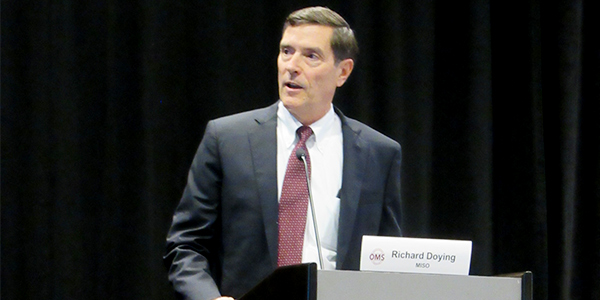By Amanda Durish Cook
NEW ORLEANS — MISO executives and some of its state regulators last week provided sharply contrasting visions of the grid’s move away from fossil fuels and toward renewables.
MISO President of Market Development Strategy Richard Doying arrived at the Organization of MISO States’ annual meeting in the Big Easy to discuss the RTO’s 2019 Forward Report, which concluded that market changes are necessary as the RTO footprint experiences demarginalization, decentralization and digitalization. (See New MISO Report Starting Point for Major Grid Change.)
The RTO had only about 400 MW of wind in 2007, CEO John Bear said. Doying noted it is now nearing 20 GW of wind generation in its mix, which can have zero marginal costs.
“That is the right economic price, but it’s terrible for baseload generation,” Doying said.
MISO’s generation interconnection queue currently contains 59 GW of solar projects and 27 GW of wind projects.
But 15 years ago, coal was king in the footprint, holding more than 75% of the generation mix; now MISO predicts that share will drop to less than 25% by 2030.
But Kentucky Public Service Commissioner Talina Mathews offered a starkly different picture. She said her state, with its continuing flat loads and lack of a renewable portfolio standard, still seems perfectly happy with 94% of its energy needs being supplied by coal and natural gas.
Kentucky doesn’t yet see a need to add renewable generation, Mathews said. For customers that do want renewable energy, she pointed out that western Kentucky, as a MISO member, can access other states’ renewable generation.
“We’re seeing change come more slowly,” she said. And as far as those “green kilowatt-hours? We’re going to sit back and let that come to us.”
“Would some people say my head is in the sand?” she mused. “Maybe.”
But many of Kentucky’s residents simply can’t afford to think about clean energy, Mathews said. To them it doesn’t matter “what color the kilowatt-hours are” as long as they come cheap.
“When your home is a pre-1970s trailer with resistance strip heating, you can’t respond to [energy] market signals,” she said, adding that many in Kentucky’s formerly booming coal country are barely scraping by.
“We have counties that are at 12% [unemployment],” Mathews said. “We have counties that are taking the hit for other people’s energy decisions. And that’s fine. That’s how economies move.”
Minnesota Public Utilities Commissioner Matt Schuerger offered yet another view. He said while renewable adoption was stimulated in the beginning by state renewable targets, they’re no longer a catalyst in 2019.
“We’ve moved beyond that several years ago. In fact, most utilities met these goal several years early,” Schuerger said.
Arkansas Public Service Commission Chairman Ted Thomas argued that energy innovation isn’t a one-step process and markets are best positioned to encourage and accommodate the series of steps — not a federal rule.
“Imagine if we still had the Clean Power Plan. You would have state policy in response to federal mandates clashing with” FERC rules, he said. Storage remains the most potentially disruptive technology that is close to mass deployment, he said. Consumer-oriented demand response is a close second.
Thomas said he agreed with Supreme Court Justice Oliver Wendell Holmes Jr.’s position that laws should be written with the “bad guy” in mind, or the one person that will try to exploit the law for personal gain. He said that advice should be carefully considered when states target certain levels of fuel mix diversity.
“There’s going to be some ‘slick’ that is going to free-ride. That’s human nature,” Thomas said.
He also said the manner in which decentralized generation is adopted remains debatable: “There’s a lot of talk that we’re going to be decentralized, but the question is how — decentralized at scale or decentralized on rooftops?”
Doying took notes during the exchange; MISO plans to release an updated version of its Forward Report in 2020.






